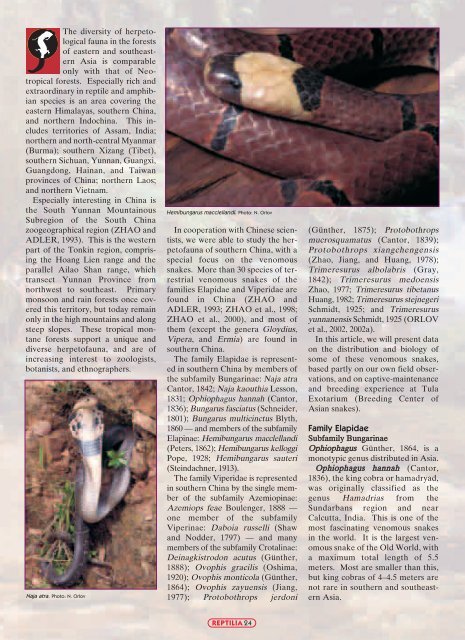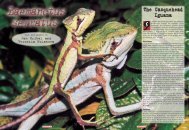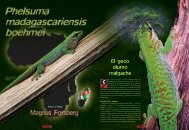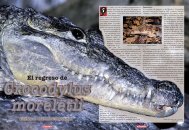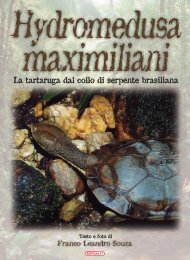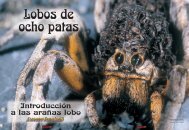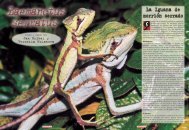Venomous Snakes of Southern China - Reptilia
Venomous Snakes of Southern China - Reptilia
Venomous Snakes of Southern China - Reptilia
Create successful ePaper yourself
Turn your PDF publications into a flip-book with our unique Google optimized e-Paper software.
The diversity <strong>of</strong> herpetological<br />
fauna in the forests<br />
<strong>of</strong> eastern and southeastern<br />
Asia is comparable<br />
only with that <strong>of</strong> Neotropical<br />
forests. Especially rich and<br />
extraordinary in reptile and amphibian<br />
species is an area covering the<br />
eastern Himalayas, southern <strong>China</strong>,<br />
and northern Indochina. This includes<br />
territories <strong>of</strong> Assam, India;<br />
northern and north-central Myanmar<br />
(Burma); southern Xizang (Tibet),<br />
southern Sichuan, Yunnan, Guangxi,<br />
Guangdong, Hainan, and Taiwan<br />
provinces <strong>of</strong> <strong>China</strong>; northern Laos;<br />
and northern Vietnam.<br />
Especially interesting in <strong>China</strong> is<br />
the South Yunnan Mountainous<br />
Subregion <strong>of</strong> the South <strong>China</strong><br />
zoogeographical region (ZHAO and<br />
ADLER, 1993). This is the western<br />
part <strong>of</strong> the Tonkin region, comprising<br />
the Hoang Lien range and the<br />
parallel Ailao Shan range, which<br />
transect Yunnan Province from<br />
northwest to southeast. Primary<br />
monsoon and rain forests once covered<br />
this territory, but today remain<br />
only in the high mountains and along<br />
steep slopes. These tropical montane<br />
forests support a unique and<br />
diverse herpet<strong>of</strong>auna, and are <strong>of</strong><br />
increasing interest to zoologists,<br />
botanists, and ethnographers.<br />
Naja atra. Photo: N. Orlov<br />
Hemibungarus macclellandi. Photo: N. Orlov<br />
In cooperation with Chinese scientists,<br />
we were able to study the herpet<strong>of</strong>auna<br />
<strong>of</strong> southern <strong>China</strong>, with a<br />
special focus on the venomous<br />
snakes. More than 30 species <strong>of</strong> terrestrial<br />
venomous snakes <strong>of</strong> the<br />
families Elapidae and Viperidae are<br />
found in <strong>China</strong> (ZHAO and<br />
ADLER, 1993; ZHAO et al., 1998;<br />
ZHAO et al., 2000), and most <strong>of</strong><br />
them (except the genera Gloydius,<br />
Vipera, and Ermia) are found in<br />
southern <strong>China</strong>.<br />
The family Elapidae is represented<br />
in southern <strong>China</strong> by members <strong>of</strong><br />
the subfamily Bungarinae: Naja atra<br />
Cantor, 1842; Naja kaouthia Lesson,<br />
1831; Ophiophagus hannah (Cantor,<br />
1836); Bungarus fasciatus (Schneider,<br />
1801); Bungarus multicinctus Blyth,<br />
1860 — and members <strong>of</strong> the subfamily<br />
Elapinae: Hemibungarus macclellandi<br />
(Peters, 1862); Hemibungarus kelloggi<br />
Pope, 1928; Hemibungarus sauteri<br />
(Steindachner, 1913).<br />
The family Viperidae is represented<br />
in southern <strong>China</strong> by the single member<br />
<strong>of</strong> the subfamily Azemiopinae:<br />
Azemiops feae Boulenger, 1888 —<br />
one member <strong>of</strong> the subfamily<br />
Viperinae: Daboia russelli (Shaw<br />
and Nodder, 1797) — and many<br />
members <strong>of</strong> the subfamily Crotalinae:<br />
Deinagkistrodon acutus (Günther,<br />
1888); Ovophis gracilis (Oshima,<br />
1920); Ovophis monticola (Günther,<br />
1864); Ovophis zayuensis (Jiang,<br />
1977); Protobothrops jerdoni<br />
REPTILIA 24<br />
(Günther, 1875); Protobothrops<br />
mucrosquamatus (Cantor, 1839);<br />
Protobothrops xiangchengensis<br />
(Zhao, Jiang, and Huang, 1978);<br />
Trimeresurus albolabris (Gray,<br />
1842); Trimeresurus medoensis<br />
Zhao, 1977; Trimeresurus tibetanus<br />
Huang, 1982; Trimeresurus stejnegeri<br />
Schmidt, 1925; and Trimeresurus<br />
yunnanensis Schmidt, 1925 (ORLOV<br />
et al., 2002, 2002a).<br />
In this article, we will present data<br />
on the distribution and biology <strong>of</strong><br />
some <strong>of</strong> these venomous snakes,<br />
based partly on our own field observations,<br />
and on captive-maintenance<br />
and breeding experience at Tula<br />
Exotarium (Breeding Center <strong>of</strong><br />
Asian snakes).<br />
Family Elapidae<br />
Subfamily Bungarinae<br />
OOpphhiioopphhaagguuss Günther, 1864, is a<br />
monotypic genus distributed in Asia.<br />
OOpphhiioopphhaagguuss hhaannnnaahh (Cantor,<br />
1836), the king cobra or hamadryad,<br />
was originally classified as the<br />
genus Hamadrias from the<br />
Sundarbans region and near<br />
Calcutta, India. This is one <strong>of</strong> the<br />
most fascinating venomous snakes<br />
in the world. It is the largest venomous<br />
snake <strong>of</strong> the Old World, with<br />
a maximum total length <strong>of</strong> 5.5<br />
meters. Most are smaller than this,<br />
but king cobras <strong>of</strong> 4–4.5 meters are<br />
not rare in southern and southeastern<br />
Asia.


